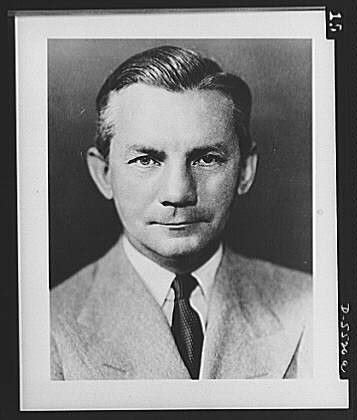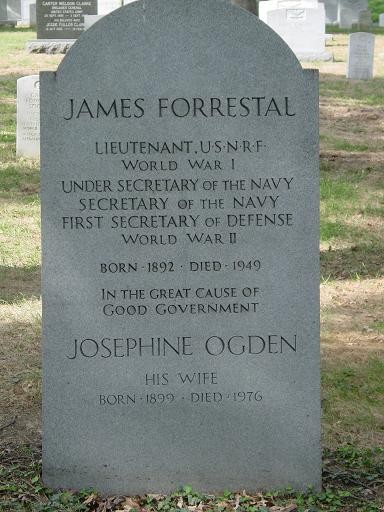In the early morning hours of May 22, 1949, the recently ousted first American Secretary of Defense, James Vincent Forrestal, committed suicide at the Bethesda Naval Hospital in Bethesda, Maryland. His death came as a shock to official Washington, where he had been a commanding figure, yet to those who knew him well, there was a certain grim logic to this tragic end.
Born in Beacon, Dutchess County, New York, on February 15, 1892, to an immigrant father and an American-born Irish mother, he sought through much of his early life to escape his origins. He attended Princeton University, where he became a major figure on campus but, for reasons that are not clear, left in the Spring of his senior year and so failed to graduate. This setback notwithstanding, he went to work for the Wall Street investment firm of William A. Read and Company (later known as Dillon Read Company). Rarely mentioning his past, or even visiting his family, he began an astonishingly swift ascent in the world of finance. He was a workaholic with a burning desire to join the ranks of the super-rich. Within a few years of his arrival on Wall Street, he made a substantial fortune in the bull market of the Roaring 20’s and was moving in glamorous social circles. In 1926, at the age of 34, he married the beautiful Josephine Ogden, a columnist for Vogue Magazine and who had once been a chorus girl with the Ziegfeld Follies. Yet as he skyrocketed to success, there were hints of the later tragedy to come. His marriage would prove to be a difficult, at times harrowing, union with a deeply unstable woman. And h himself had serious emotional problems. He was “instinctively resistant to any genuine surrendering of himself,” it has been written, and unable to make deep commitments to other people, including those he ostensibly loved. The consequences of this failure was a barren personal life and, eventually, mental collapse.
He entered the Federal Government in 1940 after two decades on Wall Street. His initial assignment was a Special Assistant to President Franklin D. Roosevelt and to aid in the military mobilization effort. In a short time, however, he was appointed Under Secretary of the Navy, where he became the prime architect of the massive Naval buildup during World War II. He flourished in wartime Washington, D.C.. His organizational genius and his appetite for seven-day work weeks enabled him to become an influential player in the Roosevelt Administration. When Secretary of the Navy William Franklin (Frank) Knox died in April 1944, he was the natural choice to replace him. This ascension to a top cabinet post occurred just as the Government began to discuss seriously its postwar security policies. He played a key role in the debate. He was suspicious of Soviet intentions and believed, long before most colleagues, that a bitter struggle with Moscow lay ahead. In the immediate aftermath of World War II, he waged a zealous crusade to alert U.S. policy makers to the Soviet threat. Forrestal believed that the Soviets were animated by messianic faith and would risk war to spread the faith. By time time of his death, his pessimistic outlook had become widely accepted.
As the nation’s first Secretary of Defense, he sought to reorganize and coordinate the country’s military services, becoming “the Godfather of the national security state.” Yet this label is ironic in the light of his initial opposition to military unification. A fierce Navy partisan, he worried that a centralized military establishment would eliminate the Navy’s autonomy. In the bureaucratic struggle over the National Security Act adopted by Congress in 1947, he lobbied hard against giving broad powers to the Secretary of Defense. Then, fatefully, he accepted the new job and discovered that he had succeeded all too well. When he took over the top Pentagon position in September 1947 he was already, in the words of a close friend, “a burned-out-case.” Over the next year, his mental and physical condition deteriorated rapidly. The frustrations of his daunting job ground him down, as did a relentless campaign against him by columnist Drew Pearson. His personal life, moreover, had become emptier than ever. Once, near the end of his life, an aide found him in his office at 9:30 in the evening and suggested that he go home. He replied bleakly, “Go home? Home to what?”
The pressures of his life had caused his behavior to become erratic by 1949 and he resigned his Defense Department post on March 1, 1949. He was admitted to Bethesda Naval Hospital (where he was placed in a 16th floor suite which had originally been built for President Franklin Roosevelt) shortly thereafter for psychiatric care.
On May 22, after several prior attempts at suicide, and after copying a passage from Sophocles’ “Chorus From Ajax,” he jumped from the 16th floor hall window. His funeral was one of only nine which have been held in the Memorial Amphitheater, took place on May 25, 1949. He was then laid to rest in Section 30 of Arlington National Cemetery.
Former Secretary of Defense James V. Forrestal
Official Funeral
22-25 May 1949
On 22 May 1949 former Secretary of Defense James V. Forrestal, the first man to hold that cabinet post, took his own life while undergoing psychiatric treatment at the U.S. Naval Hospital in Bethesda, Maryland. He was fifty-seven years old.
At the time of his death, Mrs. Forrestal and one of her two sons were in France to find a place where the former Secretary could recuperate from the depression that had overtaken him. Secretary of State Dean Acheson was also in France, having flown to Paris in President Truman’s plane, the Independence, for a meeting of the Council of Foreign Ministers. The President’s plane was put at the disposal of Mrs. Forrestal who, with her son, flew back to the United States, arriving at National Airport in Washington, D.C., early on 23 May. She was accompanied on the plane by Brigadier General Robert B. Landry, Air Force Aide to the President, and Colonel Louis Renfrow, Assistant to the Secretary of Defense. Among those on hand to meet her were the incumbent Secretary of Defense, Louis Johnson, Secretary of the Navy John L. Sullivan, former Secretary of the Army and Mrs. Kenneth C. Royall, former Under Secretary of the Army William R. Draper, her other son, and several personal friends.
Mr. Forrestal was to be given an Official Funeral, although the term was not formally used until later in 1949. Secretary of Defense Johnson designated Major General Hobart R. Gay, commander of the Military District of Washington, as his representative, responsible for planning the funeral ceremonies. This planning, accomplished on 23 and 24 May, was as simple as possible, in keeping with the wishes of the Forrestal family and those of Mr. Forrestal.
Services and burial were to take place in Arlington National Cemetery; Mr. Forrestal had served in the Navy during World War I and as Secretary of the Navy from March 1944 until he became Secretary of Defense in September 1947. The gravesite selected was in Section 30, not far from the grave of William Howard Taft.
Originally, only a simple graveside service was planned, but it quickly became apparent that even though attendance was to be limited to relatives, personal friends, and the official government family, the number of persons expected could not be accommodated at the gravesite. The final plan, therefore, called for a modest funeral service in the Memorial Amphitheater and a private burial service. The Right Reverend Wallace R. Conkling, bishop of the Episcopal Diocese of Chicago and an intimate friend of the Forrestal family, was to officiate both in the amphitheater and at the grave.
In accordance with Mrs. Forrestal’s wishes, there was to be no procession through the streets of Washington, only a cortege from the Memorial Gate of the cemetery to the amphitheater. Mr. Forrestal’s body was to be borne by hearse from the hospital in Bethesda to the gate, where the casket was to be transferred to a caisson, and accompanied to the amphitheater by a military escort.
The US Navy Band, a battalion of midshipmen from the US Naval Academy, and a composite battalion made up of a company each from the Army, Marine Corps, Navy, and Air Force were to constitute the escort. Because of Mr. Forrestal’s service and close association with the Navy, a naval escort commander, Rear Admiral John W. Roper of the Naval Bureau of Personnel, was appointed. Body bearers, who were to flank the caisson as the procession moved from Memorial Gate to the amphitheater, included two men each from the Army, Marine Corps, Navy, and Air Force.
Other military formations scheduled to participate in the ceremonies included the 3d Infantry battery, which was to fire a 19-gun salute during the procession through the cemetery and a second nineteen guns during the graveside service. The US Army Band was to play during the funeral service in the amphitheater, and the US Marine Band, at the request of the Forrestal family, was to play during the graveside service and to furnish two buglers.
Twenty-two men, all friends of Mr. Forrestal, were invited to serve as honorary pallbearers; they were not scheduled to march in the procession or to participate in the graveside service, but they were to be present at the service in the amphitheater:
- Herbert C. Hoover, former President of the United States
- Artemus L. Gates, former Assistant Secretary of the Navy for Air
- Fred M. Vinson, Chief Justice of the United States
- Cornelius V. Whitney, Under Secretary of Commerce and former Assistant Secretary of the Air Force
- General of the Army George C. Marshall former Secretary of State and former Chief of Staff, US Army
- General James A. Farley, former Postmaster General
- James F. Byrnes, former Secretary of State
- General of the Army Dwight D. Eisenhower
- John J. McCloy, former Assistant Secretary of War
- Fleet Admiral William D. Leahy, former Chief of Staff to the Commander in Chief
- Kenneth C. Royall, former Secretary of the Army
- Bernard M. Baruch
- Robert P. Patterson, former Secretary of War
- Clarence Dillon
- John L. Sullivan, Secretary of the Navy
- Nicholas S. Ludington
- Robert A. Lovett, former Under Secretary of State and former Assistant Secretary of War
- Thomas G. Corcoran
- Edward L. Shea
- Ferdinand Eberstadt
- Dean Mathey
- Paul V. Shields
At midmorning on 25 May, Rear Admiral John E. Gingrich, a long-time friend and aide to Mr. Forrestal, accompanied the former Secretary’s casket in the hearse from the Naval Hospital to the Memorial Gate of the cemetery. The military escort already was in position at the gate when the hearse arrived about 1050. In one change of plans, made when it was discovered that the US Navy Band was on tour, the US Naval Academy Band was substituted to lead the procession. After the body bearers transferred the casket to the caisson, the procession moved into the cemetery in the following order of march: US Naval Academy Band; two companies of midshipmen; national and US Naval Academy colors; two companies of midshipmen; US Army company; US Marine Corps company; service colors; US Navy company; US Air Force company; caisson and body bearers. The Forrestal family, clergy, and honorary pallbearers did not accompany the cortege, but awaited the procession at the amphitheater. As the column proceeded at the slow cadence of funeral marches played by the band, the 3d Infantry saluting battery fired nineteen guns, spacing the rounds so that the last one was fired as the caisson reached the west entrance of the amphitheater at 1115.
All persons attending the service in the amphitheater had been seated before the procession arrived. The 2,500 guests, among whom were President and Mrs. Harry S. Truman and their daughter, Margaret, Vice President Alben W. Barkley, members of the cabinet, Congress, and Supreme Court, the highest military officials of all the armed forces, and representatives of the diplomatic corps, were seated by 1100. At that time members of the public were permitted to fill unoccupied seats. Outside the amphitheater some 4,000 additional onlookers stood behind ropes to watch the arrival of the procession.
After the body bearers lifted Mr. Forrestal’s casket from the caisson, Bishop Conkling and Rear Admiral William N. Thomas, the Navy Chief of Chaplains, led the way into the amphitheater. As the Army Band played the hymn “Lead Kindly Light,” the clergy and body bearers escorted Mr. Forrestal’s casket around the colonnade to the apse. In the apse, which was shielded from the sun by a green canopy, waited the Forrestal family, President Truman, Vice President Barkley, and the honorary pallbearers.
Bishop Conkling conducted a twenty-minute service, reading from two psalms, the New Testament, and the Episcopal Book of Common Prayer. After the benediction the Army Band played a hymn, “God of Our Fathers,” while the body bearers took the casket out the west entrance and secured it to the caisson. As the procession formed and moved toward the gravesite for the private service, the Army Band played “Onward Christian Soldiers.” The amphitheater audience remained inside until the cortege had departed and President Truman had left.
Besides the Forrestal family at the graveside were the former Secretary’s aide, Admiral Gingrich, and Capt. George N. Raines, the naval hospital physician who had attended Mr. Forrestal. At the request of the family, the Marine Band played two of Mr. Forrestal’s favorite selections during the rites: Handel’s “Largo” and Rimsky-Korsakoff’s “Hymn to the Sun.” Bishop Conkling then read the Episcopal service, the 3d Infantry battery fired a 19-gun salute, and the Marine firing squad delivered three volleys. The ceremony was concluded by having one bugler blow taps and a second bugler sound the notes as an echo.
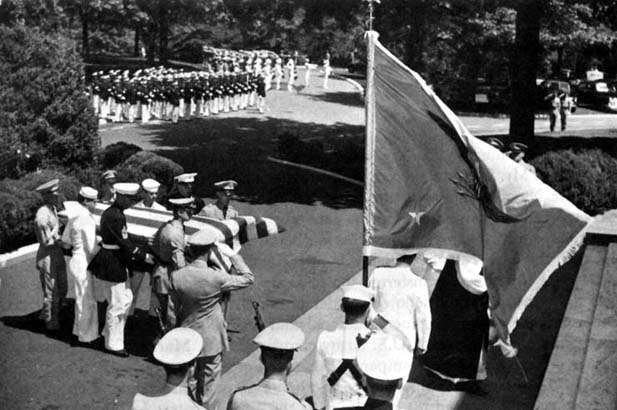
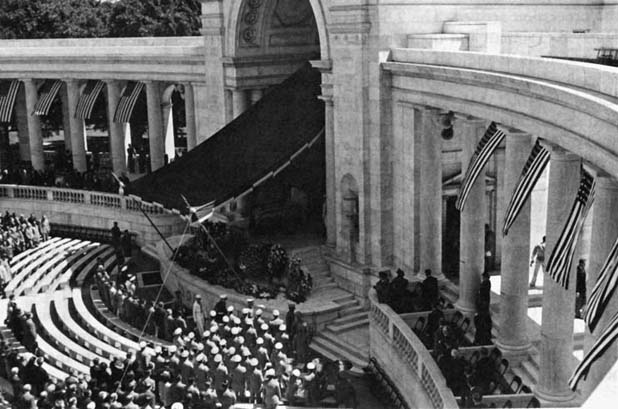
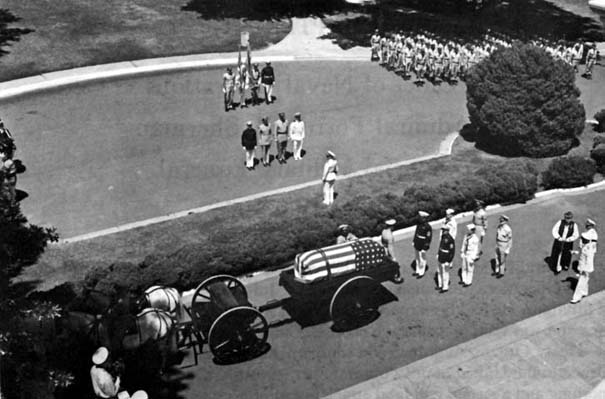
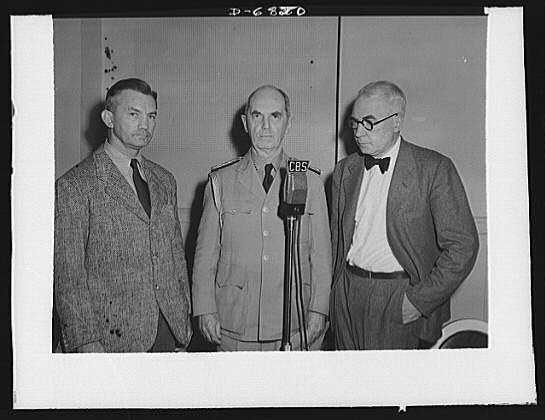
FORRESTAL, JAMES V
- LT USNRF
- VETERAN SERVICE DATES: Unknown
- DATE OF DEATH: 05/22/1949
- DATE OF INTERMENT: 05/25/1949
- BURIED AT: SECTION 30 SITE 674 SH
- ARLINGTON NATIONAL CEMETERY
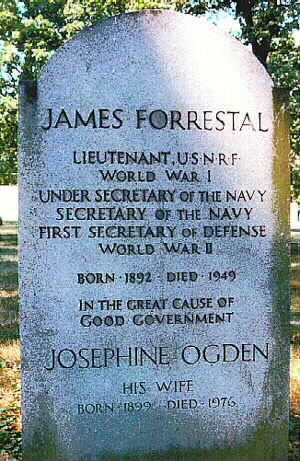
Michael Robert Patterson was born in Arlington and is the son of a former officer of the US Army. So it was no wonder that sooner or later his interests drew him to American history and especially to American military history. Many of his articles can be found on renowned portals like the New York Times, Washingtonpost or Wikipedia.
Reviewed by: Michael Howard

